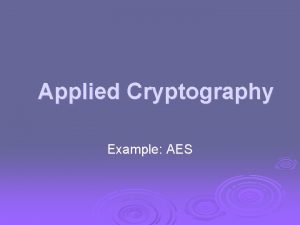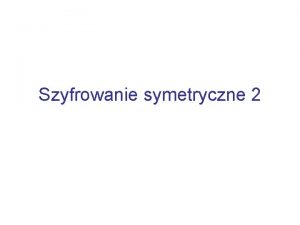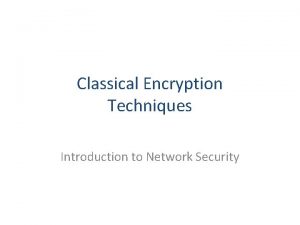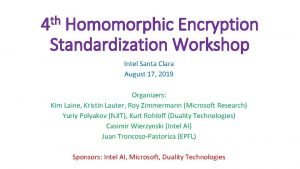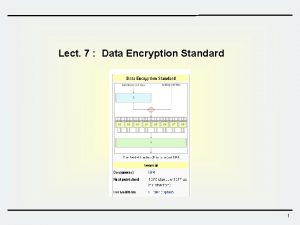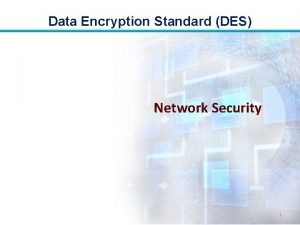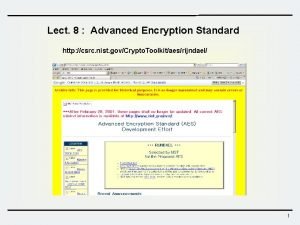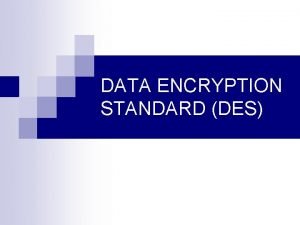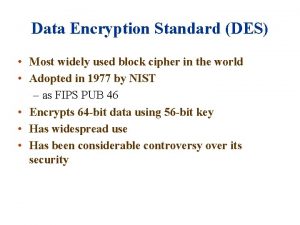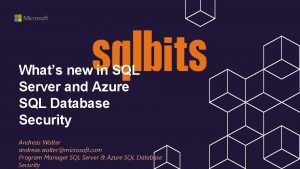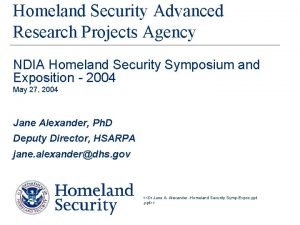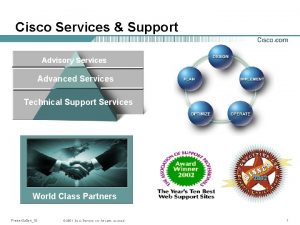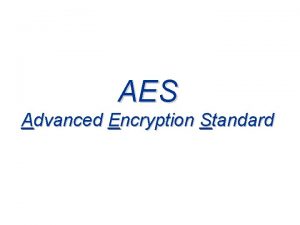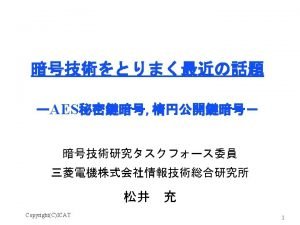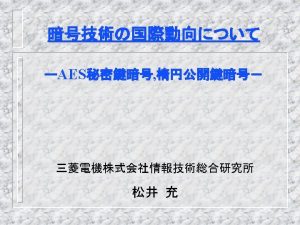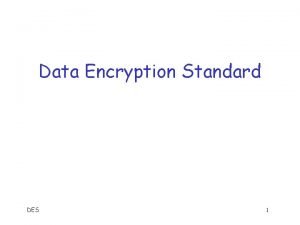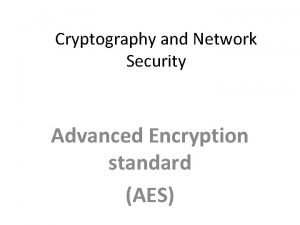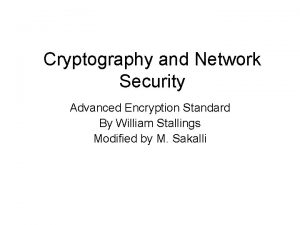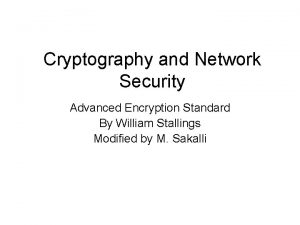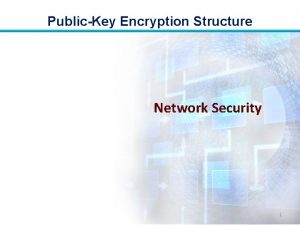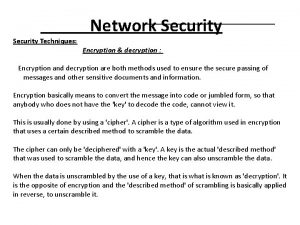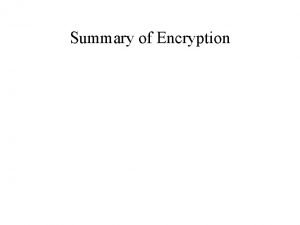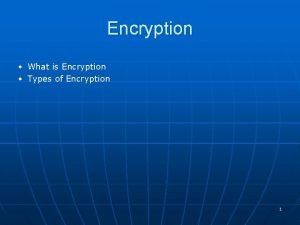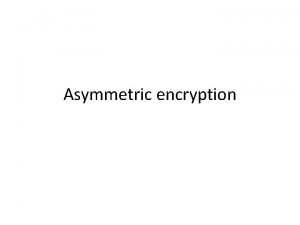Advanced Encryption Standard Network Security 1 Advanced Encryption























- Slides: 23

Advanced Encryption Standard Network Security 1

Advanced Encryption Standard Objectives of the Topic • After completing this topic, a student will be able to – describe Advanced Encryption Standard. 2

Advanced Encryption Standard Figures and material in this topic have been • adapted from “Network Security Essentials: Applications and Standards”, 2014, by William Stallings. 3

Advanced Encryption Standard • The principal drawbacks of 3 DES: • 1. It has three times as many rounds as DEA and is correspondingly slower. • 2. Both DEA and 3 DES use a 64 -bit block size. • Its not a reasonable candidate for long term use. 4

Advanced Encryption Standard • In 1997 NIST issued a call for proposals for a new AES: • 1. Should have a security strength equal to or better than 3 DES and significantly improved efficiency. 5

Advanced Encryption Standard • 2. Must be a symmetric block cipher with a block length of 128 bits and support for key lengths of 128, 192, and 256 bits. 6

Advanced Encryption Standard • 3. Evaluation criteria included security, computational efficiency, memory requirements, hardware and software suitability, and flexibility 7

Advanced Encryption Standard • NIST selected Rijndael as the proposed AES algorithm • Developers were two cryptographers from Belgium: Dr. Joan Daemen and Dr. Vincent Rijmen • published as a final standard (FIPS PUB 197) in 2001. 8

Advanced Encryption Standard • AES uses a block length of 128 bits and a key length that can be 128, 192, or 256 bits. • For our discussion, we assume 128 bits in this topic. 9

Advanced Encryption Standard • The input to the encryption and decryption algorithms is a single 128 -bit block. • In FIPS PUB 197, this block is depicted as a square matrix of bytes. 10

Advanced Encryption Standard • The block is copied into the State array, which is modified at each stage of encryption or decryption. • After the final stage, State is copied to an output matrix. 11

Advanced Encryption Standard • Similarly, the 128 -bit key is depicted as a square matrix of bytes. • This key is then expanded into an array of key schedule words: Each word is four bytes and total key schedule is 44 words for 128 -bit key. 12

Advanced Encryption Standard • Ordering of bytes in a matrix is by column. • First four bytes of a 128 -bit plaintext input to the encryption cipher occupy the first column of the in matrix, the second four bytes occupy the second column, and so on. 13

Advanced Encryption Standard • Similarly, the first four bytes of the expanded key, which form a word, occupy the first column of the w matrix. 14

Advanced Encryption Standard AES’s Working: • Four different stages are used, one of permutation and three of substitution 15

Advanced Encryption Standard • Substitute bytes: Uses a table, referred to as an S-box, to perform a byte-bybyte substitution of the block. • Shift rows: A simple permutation that is performed row by row. 16

Advanced Encryption Standard • Mix columns: A substitution that alters each byte in a column as a function of all of the bytes in the column. • Add round key: A simple bitwise XOR of the current block with a portion of the expanded key. 17

Advanced Encryption Standard 18

Advanced Encryption Standard Internal Details of a round. 19

Advanced Encryption Standard 20

Advanced Encryption Standard Some comments: • AES structure is not a Feistel structure. • For both encryption and decryption, the cipher begins with an Add Round Key stage, followed by nine rounds that each includes all four stages 21

Advanced Encryption Standard • Each stage is easily reversible. • The final round of both encryption and decryption consists of only three stages. • The decryption algorithm is not identical to the encryption algorithm. 22

Advanced Encryption Standard • The decryption algorithm makes use of the expanded key in reverse order. End 23
 Advanced encryption standard example
Advanced encryption standard example Aes (ang. advanced encryption standard)
Aes (ang. advanced encryption standard) Classical encryption techniques
Classical encryption techniques Private secruity
Private secruity Osi security model
Osi security model Guide to network security
Guide to network security Wireless security in cryptography
Wireless security in cryptography Electronic mail security in network security
Electronic mail security in network security Security guide to network security fundamentals
Security guide to network security fundamentals Security guide to network security fundamentals
Security guide to network security fundamentals Homomorphic encryption standard
Homomorphic encryption standard Block ciphers and the data encryption standard
Block ciphers and the data encryption standard Data encryption standard exercice corrigé
Data encryption standard exercice corrigé Data encryption standard
Data encryption standard Des in information security
Des in information security Csrc nist
Csrc nist Data encryption standard history
Data encryption standard history Desmost
Desmost Azure sql server advanced data security
Azure sql server advanced data security Oracle advanced security
Oracle advanced security Hsarpa sbir
Hsarpa sbir Homeland security advanced research projects agency
Homeland security advanced research projects agency Cisco advanced services security
Cisco advanced services security Advanced fms & security services pvt ltd
Advanced fms & security services pvt ltd
